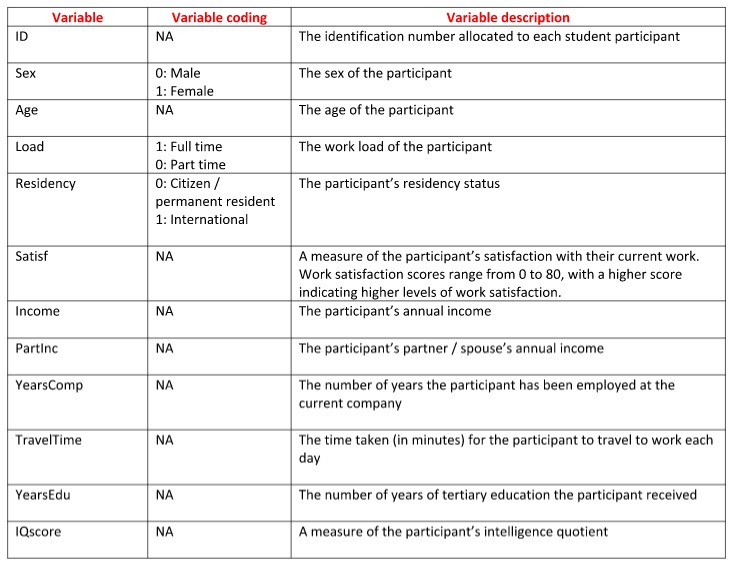Information on the data:
This assignment relates to the SPSS data file Assignment. The primary aim of this hypothetical study was to investigate the factors which affect work satisfaction. The study was conducted on a random sample of adult office workers at a large company in Melbourne. The workers completed a series of questionnaires and inventories pertaining to demographic data, work data and work satisfaction. The variables examined are described below:

Question 1:
The research team at a large Melbourne based company has hypothesised that workers who take less time to travel to work each day will generally be more satisfied with their work life. Use the data from the Assignment data file to investigate this hypothesis. Write a brief report on your results, including an appropriate hypothesis test. Quote all relevant statistics and appendix relevant output.
Question 2:
In a follow up study, the researchers decided to investigate the factors which affect annual income for their sample of office workers. The researchers included the following predictors into their model: (1) Age, (2) Years of Tertiary education, and (3) sex. The researchers hypothesised that:
1) People with more years of tertiary education will have higher annual incomes
2) Older people will have higher annual incomes
3) Males will have higher annual incomes than females
Using the data from the Assignment data file, the researchers have provided a report to address these research hypotheses:
A. A study was conducted to explore factors affecting the annual income of workers from a Melbourne-based company. The researchers proposed that people with more years of tertiary education would have higher annual incomes. They also suggested that older people would have higher annual incomes. Finally, they suggested that males would have higher annual incomes than females. A multiple regression was performed on this data with income as the independent variable. Three predictors were included in the model: Age, years of tertiary education and sex (male/female).
B. The intercorrelations between the variables are given in Table 1, and the regression statistics are given in Table 2.

C. As can be seen from Table 1, only sex was not significantly correlated with income. There were however, significant positive relationships between income and the other predictors. People with more years of tertiary education tend to have higher annual incomes, as did younger workers.
D. The three predictors together explain 60.7% of the variation in annual income, and this is significant F(3,149) = 75.07, p < .001. When all of the predictors are taken into account, age is no longer significant (see Table 2). The correlation between age and income can be explained in terms of years of tertiary education. Older people tended to have more years of tertiary education and people with more years of tertiary education tended to have higher annual incomes. The most important predictor of income in this model was years of tertiary education. People with more years of tertiary education tended to have higher annual incomes.
E. As expected years of tertiary education had an indirect effect on income, with more years of tertiary education resulting in higher annual incomes. Also as expected, older people also tend to have higher incomes, but only because they have more years of tertiary education. Contrary to expectations, there is insufficient evidence to suggest that the sex of a person has an effect on their income.